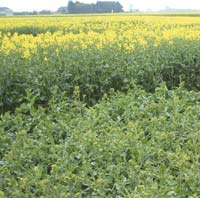Low biomass hybrids get seal of approval

Growers who look no further than the top of the Recommended List when choosing their oilseed rape varieties could be missing a trick, results from ongoing trials suggest.
Two low biomass hybrid oilseed rapes feature for the first time on that list this year – but both appear to be well off the pace when it comes to gross output.
Dekalb’s newcomer, DK Secure, scores a 103 in the north, 11 points behind Catana from the same stable and nine behind DSV’s Flash. In the east and west it scores 98, compared with 111 for Pioneer’s PR46W21 and 108 for DSV’s Dimension.
Pioneer’s offering, PR45D03, recommended for the east and west only, scores 99.
But, despite those seemingly low scores, Dick Neale at Hutchinsons in Wisbech sees this latest generation of semi-dwarf varieties as the start of a real breakthrough for UK oilseed rape growing.
After two seasons assessing them, he believes they offer a combination of management ease and flexibility, with commercial gross outputs that can match the best of today’s varieties. “As a result they’ve been proving increasingly popular with clients who’ve been looking at them with us.”
Such varieties can, he adds, can be drilled early and pushed to yield without any real lodging risk, fertilised and sprayed through the whole growing season without specialised equipment and direct combined 30% faster than most without significant losses.
“Semi-dwarf OSRs appealed to us for their management possibilities when we first came across them in the late 1990s,” he recalls. “But yields were too far off the pace. In contrast, the newly Recommended varieties have gross outputs only just under the trial mean, despite a husbandry regime that doesn’t get anywhere near the best out of them.
“When we and an increasing number of our clients grow the same varieties on a field scale, with the agronomy they do need and without the swathing they so clearly don’t, it’s a very different story. On every occasion they perform at least as well as other varieties grown alongside them and often give a good half a tonne a hectare more. There’s an even greater yield and quality advantage over traditional types when they’re subject to the sort of wind and rain lashing we saw in some parts of the country last season.”
Low biomass hybrids can be drilled in mid-August at a decent seed rate in the fertile ground they suit, says Mr Neale. “Because the crop won’t get much over waist height you also have the flexibility to put on your nitrogen and fungicides when needed. And you can use standard farm equipment.”
Harvesting is quicker, Mr Neale notes. Instead of perhaps 3ha/hr using a high capacity combine in a reasonable crop, a similar-yielding low biomass hybrid can be cut at over 4ha/hour. Little seed is lost over the header, and less haulm minimises losses over the sieves. That means far fewer volunteer problems and less trash to incorporate, he adds.
| Different growth habit Growers new to low biomass hybrids will have to get used to a very different growth habit, says Mr Neale. Although plants establish as well as conventional types, and are equally competitive against weeds and fare no worse from pigeons, they are much more compact and prostrate and initially look smaller – tighter and bushier. After they’ve grown to around 15cm (with a tight mass of flower buds in the head over an equally dense leaf mass) they appear to stop growing for around 10 days while conventional varieties shoot upwards. Then the flower head grows away and the whole plant flowers at once. “At least 50% of our growers rang me up at green bud stage last spring worried that their crops weren’t doing anything,” says Mr Neale. “But those crops are actually developing just as effectively, but not wasting resources on unnecessary stem extension. “We’ve had a hugely positive reaction from nearly every grower we’ve worked with to date,” he adds. “The varieties we have today are most valuable for higher fertility sites, where the workload pressure on sowing or harvesting is particularly acute and wherever growers want to build a more efficient and flexible OSR management approach.” |
|---|

